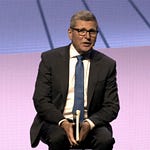Earlier this year, I spoke with Dr. Bjorn Peters—a physicist-turned-energy economist who once believed in the promise of Germany’s energy revolution. Back in 2008, as a senior adviser in Deutsche Bank’s asset management arm, Peters helped direct billions of euros into wind and solar projects.
But the deeper he looked, the more sceptical he became about the wisdom of building an electricity grid around weather-dependent generators.
“It means decentralized energy production, but not decentralized energy supply. And that’s one of those very fundamental flaws in thinking that led us astray.”
Wind and solar are intermittent and highly correlated. They flood the grid in fair weather, then vanish together in cloudy stillness. On their own, they will never deliver 24/7 power. And there is still no economical way to store electricity at the scale and duration needed to keep a modern industrial society running.
🔗 IEA – Grid Stability and Storage
It’s why Germany has exported a new word: Dunkelflaute—“the dark doldrums”—describing periods when there is little sun and no wind across large regions, sometimes for days or even weeks.
🔗 Dunkelflaute
At such times, all of the vastly distributed energy gatherers need a 100 percent backup from gas, coal or energy imports. And what’s true in Germany is true always and everywhere. So what was sold as a bold vision has become a cautionary tale.
The Anti-Nuclear Crusade
Peters corrected me when I suggested the policy began with good intentions. He explained it started in the 1970s, driven by the anti-nuclear politics of the Green movement. The aim was not to decarbonise, but to dismantle powerful, state-run utilities—and that meant shutting down nuclear power. That exercise in national self-harm that is now complete.
“The targets of the energy transition were much more about social change than climate policy. That’s why they phased out nuclear first—something you can’t explain to anyone nowadays.”
What followed was predictable. And devastating.
Germany has now spent more than €700 billion—over a trillion Australian dollars—trying to reinvent its power system.
🔗 Germany's Energiewende
The outcome?
Electricity prices among the highest in Europe.
🔗 Eurostat 2023Industrial decline, with companies fleeing Germany.
🔗 BASF and chemical sector cutsEmissions per kilowatt-hour much higher than in nuclear-powered France.
🔗 [IEA 2022 – France vs Germany power sector emissions]And a shift from power exporter to net importer—buying nuclear energy from France after shutting down its own fleet.
🔗 Germany becomes power importer
Germany’s grid shopfront was green, but its industrial engine ran on Russian gas. When the invasion of Ukraine cut that supply, the facade cracked—and the fragility of the system was exposed
.
Industry Stayed Silent
Peters sees this not just as a policy failure, but a failure of courage.
“Because of this element of fear, the industry leaders didn’t dare to speak up—or did it in the wrong way. They communicated much more to their peers, but not to the broader public.”
Politicians, meanwhile, remain wedded to illusions. But change might be coming.
A study shows that several of Germany’s shuttered nuclear plants could be restarted—two with minimal effort, and seven more with moderate investment. The economics are compelling: a typical plant generates around €1 million a day in profit.
🔗 Nuclear Restart Potential in Germany
Peters helped launch the “Nuclear Pride Coalition” in 2018 and believes public opinion is shifting.
🔗 YouGov Germany – Nuclear support polling, 2023
Net Zero a Road to Nowhere
Most of Europe, the UK, and Australia continue to pursue decarbonisation at great cost. But the world’s biggest emitters—China, Russia, India, and the United States—have no intention of following the same timeline.
So Peters believes this all points to one end.
“These types of climate policies with their fallacies are not sustainable.”
Dr. Bjorn Peters:
🔗 linkedin.com/in/björn-peters-5996777b












Share this post